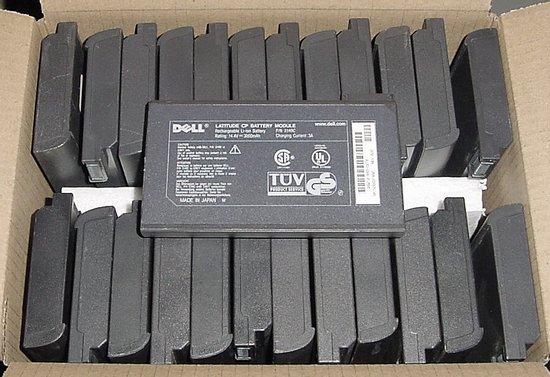I even got a plastic ammo can that fits them perfectly.
At one point, when I thought I had some money to spend, I made a spreadsheet comparing various kinds of batteries in terms of cost, range on my bike, and the most useful metric, $/Wh. You can always take smaller packs and put them together into a large battery pack, so it's not the cost that matters, but how much you're paying per unit of energy. It's also useful for comparing between different types of batteries. You can look at this spreadsheet here, or like almost all the document for this project, it's in the Google Drive folder linked in the sidebar.
Lead acid batteries, as I said above, are pretty poor batteries in almost every way, except that they are incredibly cheap. I won't get into the other kinds of lead acid batteries, but the most common sizes of sealed lead acid batteries are around $0.10/Wh.
Most home-built electric vehicles built now use Prismatic Lithium Ion cells, because they are very large (ranging in size from paperbacks to telephone books) and thus fewer are needed, making them easier to work with. They usually use Lithium Iron Phosphate (LiFePo4) based chemistries, because they are extremely stable and can't catch on fire unlike the other Li-on chemistries. The gold standard right now are the CALB CA cells, which are around $0.40/Wh.
Most commercially built electric vehicles use much smaller, cylindrical cells, such as the 18650, 26650, and 32600 batteries. They can store more energy in a smaller volume than the prismatic cells, the small size provides redundancy in case a few fail, and a number of other advantages in mass production of vehicles, such as easier cooling.The numbers refer to the physical size, for example an 18650, commonly used in laptop batteries and high end flashlights, is 18mm in diameter and 65mm long, which looks like a larger AA battery. The Tesla Model S, for example uses Panasonic NCR18650B cells, which cost $0.49/Wh in medium volumes. Some cylindrical cells, such as the very high quality LiFePo4 18650 cells made by A123, cost upwards of $2/Wh.
 |
| The NCR18650Bs I use in my flashlights |
You may have noticed that I said the cells used in the Tesla are the same as a laptop. And you've probably had an old computer whose battery life just went to zero one day. What you probably didn't know is that most of the cells in that battery were just fine. Most laptop batteries have 6 cells in them (3 in series, 2 in parallel, 3S2P), although a few are 9 (3S3P), or even more rarely, 8 (4S2P). When your battery stops holding a charge, it's really just the weakest of those six cells that won't work. It damages the one it's paired to and the other four are totally fine. And so what people do is open up the batteries, figure out which cells are any good, and then reuse them. This type of battery recycling is surprisingly easy, as long as you don't mind destroying the plastic enclosures that are glued shut around them. There are even factories making good money in China slapping a new label on these used cells and selling them as new (looking at you Ultra/Trust/Sure/UranusFire). You can buy old laptop batteries off of eBay for around $10 a piece, which if you assume you will get an average of 4 working cells at 2Ah a piece, is $0.34/Wh, about the same price as RC LiPo.
However, most people treat these as trash, a hazardous waste to be disposed of (even though they're not toxic, only flammable), instead of as a valuable asset. Of the two local computer stores I visited, one said they already have a contract to give all of their electronics waste to someone, and the other, Computers for Change in Burlington, was happy to give me both dead batteries they had on hand, and said they would bring more from their repair shop. For anyone else thinking of doing this, I should make a guide at some point, but every removable non-Apple laptop battery I've seen has 18650 cells in it. These laptop cells are optimized for energy, not power, by saving space with thinner plates for their electrodes, and so I need a lot of batteries just to get the bike working. I'm going to make a pack that is 10 cells in series, and a minimum of 10 cells in parallel. That's 100 cells or 25 laptop's worth just to get started, with the ultimate goal of around 200 cells. I really should make sure that'll fit in the box. Until I get to that 100 cell number, and have the materials I need to put the pack together, I'm going to keep using the lead acid.
 |
| Cracking open a Toshiba laptop battery. |
.jpg) |
| Six Sanyo Cells |
 |
| Most of my laptop salvaged batteries |





No comments:
Post a Comment